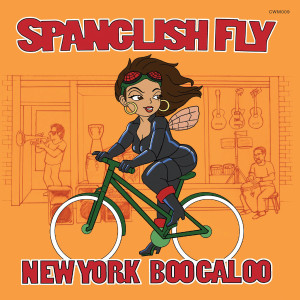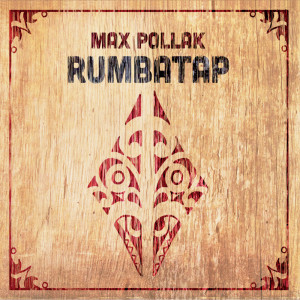It’s been a long, hot summer where I live, and it’s lingering into the fall. Latin jazz is perfect for hot weather, and here are three releases I’ve been enjoying. All of them are just a little bit different from your run-of-the-mill Latin jazz, as you’ll see.
Spanglish Fly’s New York Boogaloo
“How’s yer boogaloo, baby?” came the growling voice of Wolfman Jack over the radio from  super-station XERB “the mighty Ten-Ninety over Los Angeles” on summer nights of my adolescence. “What’s a boogaloo?” I wondered. Thanks to the slinky, kinky New York band Spanglish Fly, now I know, and you can too! Latin boogaloo is back.
super-station XERB “the mighty Ten-Ninety over Los Angeles” on summer nights of my adolescence. “What’s a boogaloo?” I wondered. Thanks to the slinky, kinky New York band Spanglish Fly, now I know, and you can too! Latin boogaloo is back.
Boogaloo was the creation of Puerto Rican musicians in mid-20th-century New York, an amalgam of blues chord structures, lyrics in English and Spanish (or “Spanglish”), soul, R&B, Latin jazz and Afro-Caribbean rhythms. Designed with one thing in mind, to get you dancing. It was overshadowed by salsa sometime in the ’70s, but some outfits like Spanglish Fly are bringing it back.
This is fun-fun-fun music, sexy as the song “Bump (And Let It Slide)” implies, subversive “Return Of The Po-Po”) and hip-sexy-subversive all at once like “Me Gusta Mi Bicicleta” in which vocalist Erica Ramos encourages a would-be paramour to get off the couch and onto a bike. Throughout there are nods to disparate American musical threads, from Woody Guthrie (the opening track “Esta Tierra” is a boogaloo version of his “This Land Is Your Land”) to Brill and Motown (the melody of “Love Graffiti Me” draws heavily on “The Loco-motion”) to “Take Me Out To The Ball Game” and even John Coltrane.
At the center of the album is a true old-school boogaloo song, Willie Colón’s “Mira Ven Aca,” which I surprised myself by knowing, somehow. It’s bookended by pianist Martin Wallace’s original instrumental “Martian Boogaloo” and the band’s tribute to retired Yankee closer Mariano Rivera “42 (El Cuarenta Y Dos).”
That’s a powerful one-two-three knockout combination right there. And if that’s not enough, “Martian Boogaloo” gets reprised on the final track in a remixed version called “Brooklyn Boogaloo” with lyrics written and performed by Ramos.
You don’t have to be a “Nuyorican” or bilingual to love Spanglish Fly.
Chaco World Music, 2015
Quarter Street’s self-titled release
 Speaking of old-school, here’s an old-school salsa release from the Australian band Quarter Street. Salsa as a genre grew out of the same time and place as Latin boogaloo, 1970s New York, largely by and for the city’s Puerto Rican residents, or “Nuyoricans.” But where boogaloo was a Latinized combination of rock and R&B, salsa came mostly from Cuban jazz, which was combined, spiced up, and adulterated with bits from all over Latin America and the Caribbean. Since then it has become a world music phenomenon and a little formulaic – fast, powerful and poppy, with little of the subtlety of the original – all hot peppers, if you will, and not enough of the other spices that give it variety.
Speaking of old-school, here’s an old-school salsa release from the Australian band Quarter Street. Salsa as a genre grew out of the same time and place as Latin boogaloo, 1970s New York, largely by and for the city’s Puerto Rican residents, or “Nuyoricans.” But where boogaloo was a Latinized combination of rock and R&B, salsa came mostly from Cuban jazz, which was combined, spiced up, and adulterated with bits from all over Latin America and the Caribbean. Since then it has become a world music phenomenon and a little formulaic – fast, powerful and poppy, with little of the subtlety of the original – all hot peppers, if you will, and not enough of the other spices that give it variety.
From the opening notes of the first track “Fantasía” this is hot, charging, classic salsa dura. The piano (Andrew James), electric bass (Cesar “Fito” Saavedra) and trombone play a repeated two-note riff in unison several times before the percussion kicks in, and salsero Sergio Botero’s beefy tenor voice commands “¡Oiga Papa!” Listen up! The group is rounded out by Luis Poblete on vocals and congas, and brothers Cesar and Cristian Saavedra on baby bass and timbales, with a three-trombone blast from Ben Gillespie, Jimmy Bowman and Lazaro Numa, who also plays trumpet.
Botero tosses off improvised vocal riffs in the son style with the best of them on songs like the second track “Tumba La Caña Jibarito” which may be the hottest track on this eight-song date. “Los Golpes Enseñan” and “De Cualquier Manera” are more laid back cha-chas that let Botero show off his smoother side; “Se Casa La Rumba” is, well, a rumba with cool electric piano for that ’70s vibe. “Libre Soy” is a well-known salsa dura in the mambo vein – the duet of tenor and bass trombones here is beautiful. And the closer “La Quarter Llego” is close to funk with its up-front bass guitar line and nearly psychedelic electric piano.
I didn’t know I liked salsa so much, probably because most of what I’ve heard has been the slicker contemporary variety. This salsa dura makes me unreasonably happy. You can stream several tracks and find links to buy the album in various formats on the Quarter Street page of Hope Street’s website. The band also has a website .
(Hope Street, 2015)
Max Pollak’s RumbaTap
This is a unique recording, recommended for fans of Cuban jazz, Afro-Latin polyrhythmic  percussion and especially percussive dance. New Yorker Max Pollak has spent his life studying and performing all three, and on his debut release as leader he presents a program that documents the evolution of what he calls RumbaTap – a portmanteau of the Afro-Cuban dance form rumba and the Afro-American jazz dance known as tap.
percussion and especially percussive dance. New Yorker Max Pollak has spent his life studying and performing all three, and on his debut release as leader he presents a program that documents the evolution of what he calls RumbaTap – a portmanteau of the Afro-Cuban dance form rumba and the Afro-American jazz dance known as tap.
The performers here are Pollak, the musicians and dancers of RumbaTap and special guests saxophonist Paul Carlon, Cuban rumbero drummer and singer Pedrito Martinez, and Afro-Latin jazz icon Bobby Sanabria. Pollak and his dancers perform on seven specially designed and miked wooden dance surfaces, replacing most of the drums and percussion instruments normally used in rumba, bomba, son, etc., with their foot percussion.
It’s at times a little academic, particularly as an audio experience. Here’s a performance video of Pollak with a Cuban jazz orchestra. As you will see, he is quite the performer, singing, dancing and doing percussive body work, all while engaging a “serious” audience.
This CD opens with “Elegua,” in which the sounds are introduced, plus some jazzy soprano sax work from Carlon. There follow a suite of short “bomba sham” pieces combining the sexy “bomba” dance with the tap “shim sham” move. Carlon and Martinez shine on “Weird Latin, a sweet piece with dancers, conga and sax. I really love the version this group does of “El Cuarto De Tula,” a well-known Cuban standard from the Buena Vista Social Club repertoire. This one is stripped-down to just Pollak’s dance percussion and claves, sax, and three-part vocals.
Other highlights include “Big Chief,” a Dr. John cover and tribute to the New Orleans sound with a Cubanized rhythm; and “Mongo T Suite,” a three-part tribute to Mongo Santamaria beginning with “Afro Blue,” best known from John Coltrane’s performances.
RumbaTap probably isn’t for everyone, but if you’re really into the rhythmic basis of Latin jazz, it’s a fascinating excursion into one man’s vision for a way to dance the music. And musically, these performances are top-notch as well.
self-released, 2015
Max Pollak has a website, and you can preview and buy this disc at CDBaby.
